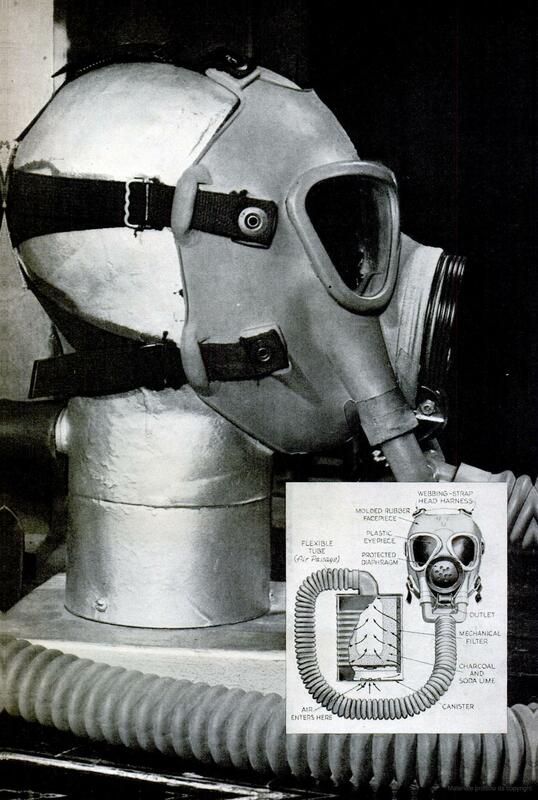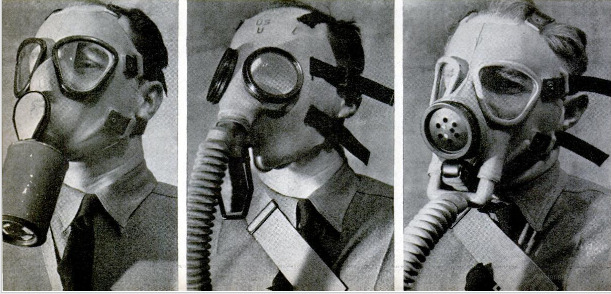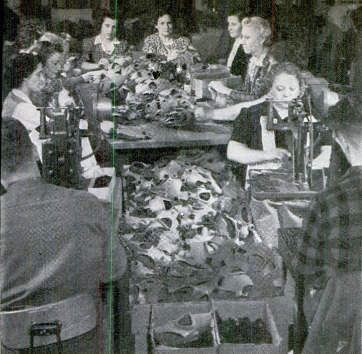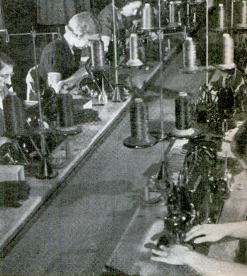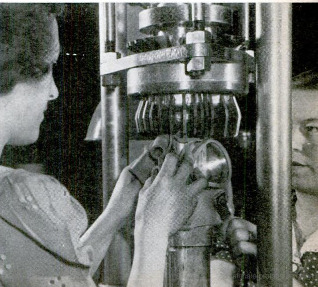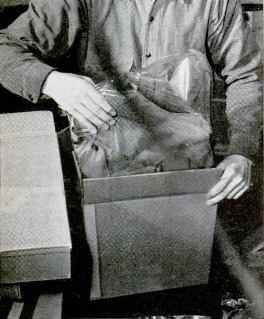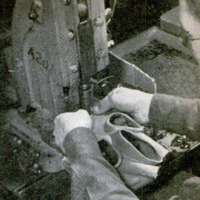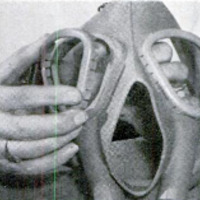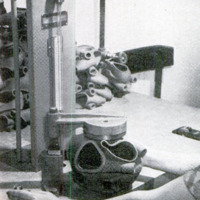-
Title (Dublin Core)
-
Poison gas defense is the army chemist's job
-
Article Title and/or Image Caption (Dublin Core)
-
Title: Poison gas defense is the army chemist's job
-
extracted text (Extract Text)
-
Gas covers a far greater area, pound for
pound, than high explosives or other impact
weapons. Thus, one medium bomber, carry-
ing four 550-pound bombs filled with a non-
persistent gas such as phosgene, under
favorable conditions can establish in a sin-
gle flight an effective concentration over
four circular areas, each about 300 yards in
diameter. At this rate, a squadron of
twelve bombers in one flight can cover a
square mile with such a concentration that
every unprotected person would become a
fatal or serious casualty.
If persistent gas such as mustard were
employed in small (22-pound) bombs, one
medium bomber could create in a single
flight 100 centers of contamination, each ap-
proximately 40 yards in diameter. The area
thus covered (126,000 square yards) is the
equivalent of five average city blocks. If the
persistent gas were sprayed, instead of
dropped in bombs, each plane could cover an
area a mile long and 1/6 mile wide, and one
squadron of 12 bombers, an area of two
square miles. While the concentrations thus
produced would cause but few deaths, nearly
every unprotected person in the area cov-
ered would become a casualty.
In addition to its greater coverage, gas
also would have a very marked searching
effect. By filtering through cracks and
crevices and flowing into every nook and
cranny, it reaches every part of the area
covered, even places protected from the fire
of other weapons. Persistent geses (such as
mustard) also have a long duration of action
and remain effective over periods of time
which vary from several hours in summer
to several days in winter. Many gases also
have high powers of penetration. Thus mus-
tard gas readily goes through all ordinary |
clothing and even through leather and rub- |
ber; it also quickly soaks into wood and con- |
crete and is exceedingly difficult to remove.
Finally, gas has a powerful psychological
effect because it is usually invisible and its
powers and limitations are not generally un-
derstood. The human mind instinctively
fears the unseen and unknown, and the
harmful effects of gas are thus greatly mag- |
nified by the imagination. This moral effect |
is of special importance in gas attacks on |
the great cities, as it may easily lead to
widespread panic and demoralization of the
civil population.
Owing to the characteristics mentioned |
above, gas is a powerful defensive weapon.
It may be quickly laid down by low-flying
attack planes and chemical tanks in broad
belts across a front to be defended and thus
provide a serious barrier to enemy attack-
ing troops which must traverse such con-
taminated zones. While it is, of course, pos- |
sible to gasproof tanks and other mech-
anized vehicles, it is exceedingly difficult to
keep them gas-tight under battle conditions
and widespread casualties to mechanized
troops would undoubtedly result from trav-
ersing gas-contaminated areas. Also, the
wearing of masks and protective clothing
materially reduces the combat efficiency of
troops, especially where they are compelled |
to wear such equipment for many hours at
a time of great physical exertion.
Recognizing the seriousness of gas at-
tacks, especially upon the large cities, every
country in Europe has taken far-reaching
‘measures to protect its army and urban pop-
ulation from this threat.
In addition to providing means for warn-
ing soldiers and citizens of impending gas
attacks and educating them as to the nature
of gas and what to do to protect themselves
against it, chemical defense comprises three
general measures of protection: (1) gas
masks and protective clothing for each in-
dividual: (2) gasproof shelters or refuge
rooms for groups of persons: and (3) de-
contamination of ground, buildings, and ma-
terials in contaminated areas.
‘The principal gas masks used in the Amer-
ican Army are the standard service mask
for combat and the training mask for train-
ing troops. These are supplemented by the
issue to certain troops of special types of
‘masks, such as diaphragm and optical masks,
which enable them to carry on their combat
duties when masked.
The Army service mask consists of three
principal parts: facepiece, canister, and
hose. The facepiece is died out of molded
rubber blank covered on the outside with a
thin layer of cotton fabric which is vulcan-
ized to the rubber. After cutting to exact
size, the blank is folded and the two short
edges are sewn together and taped with ad-
hesive tape, forming a gas-tight seam which
fits under the chin.
‘The eyepleces are made of shatterproof
glass held in the facepiece by detachable
screw-type retaining rims. The facepiece is
connected to the hose by means of an angle
tube made of die-cast aluminum which also
forms the seat for the rubber outlet valve.
Six elastic tapes (called the head harness)
hold the facepiece against the face with a
gas-tight fit.
Army service masks were formerly made
in five sizes in order to fit any size or shape
of face. Recently, however, a new-type uni-
versal facepiece has been developed which
fits 95% of all sizes and shapes of faces. The
five percent of men who cannot be fitted with
a universal mask must still be furnished
with special sizes (about four percent with
small, and one percent with large sizes).
Even though it does not fit all faces, the
universal mask greatly simplifies the prob-
lem of manufacture, fitting, and supply in
the field.
The canister of the Army service mask is
a rectangular sheet-metal box which con-
tains the chemical filling and the mechanical
filter which remove toxic gas and smoke
from the inspired air. The chemical filling
comprises about
3/4 pound of an intimate mixture of 80 per-
cent activated charcoal and 20 percent soda
lime, which is composed of hydrated lime, ce-
ment, kieselguhr, sodium hydroxide, and wa-
ter. ‘The mechanical filter consists of a
cylindrical sleeve made of fibrous material
of such fine porosity that the solid particles
of toxic smoke are screened out of the air
passing through the material.
The inhaled air enters the canister
through a rubber disk inlet valve in the bot-
tom and is drawn first through the mechan-
ical filter where any solid or liquid particles
are screened out. The air then passes
through the chemical contents of the can-
ister where the toxic vapors are absorbed by
te charcoal or neutralized by the soda lime.
Gases which the charcoal does not hold firm-
ly by absorption (for example, phosgene)
are gradually released by it and are caught
by the soda lime, with which they enter into
chemical combination.
The hose which connects the canister to
the facepiece is a corrugated rubber tube
covered with cotton stockinette. The corru-
gations preserve flexibility and prevent the
tube from collapsing.
The carrier is a canvas satchel provided
with adjustable shoulder and waist straps
which permit it to be carried at the left side
under the arm, The opening at the front
permits the mask to be adjusted to the face
without changing the position of the carrier
as was necessary with our World War
masks.
Another recent improvement in the Army
service mask is the development of a sound-
transmitting diaphragm which is mounted
in a specially designed angle tube and per-
mits clearer transmission of oral commands
and telephone conversation. Diaphragm
masks may also be made with special eye
lenses adapted to fit observing instruments,
such as range finders and telescopes, and are
then known as optical masks. These are is-
sued only to soldiers having duties requir-
ing them to use optical instruments.
Recently developed in this country, the
so-called “training mask’ was designed for
the purpose of supplying the Army with a
cheap and lightweight gas mask for training
purposes. It differs from the standard Army
service mask, not only in design and con-
struction, but also in the process of manu-
facture which embodies many of the latest
innovations in gas-mask production. The
training mask is of the snout-type—that is,
the canister is attached directly to the face-
piece, thereby eliminating the hose tube. As
compared with the service mask, the train-
ing mask is lighter in weight, has a smaller
canister, and the facepiece is fully molded,
instead of fabricated, into final shape.
The facepiece of the training mask is of
universal size, with an integrally molded
air-supply tube and deflector. The eyepieces
of cellulose acetate are crimped on the face-
piece and are not round, as in the service
mask, but are specially shaped to afford
maximum vision. The facepiece fits closer
to the face and thus reduces to a minimum
the dead air space within the mask. The out-
let valve is of the circular disk type and
seats against a molded rubber seat within
the angle tube.
The canister is cylindrical in shape and
somewhat smaller than the standard service
canister. It, however, contains the same
kind of chemical contents and has a me-
chanical filter for removing toxic smoke.
Air enters through an inlet valve in the bot-
tom of the canister. Since the training can-
ister is smaller than the standard service
canister, it has a shorter life in gas concen-
trations and a higher breathing resistance.
It will, however, protect against all standard
chemical agents with a degree of protec-
tion equal to the standard canister.
‘The carrier of the training mask is a
lightweight cloth bag with a single adjust-
able shoulder strap which is held against the
left side of the body by a cord passing
around the waist.
By molding the facepiece instead of fab-
ricating it, as in the standard service mask,
not only is the process of manufacture sim-
plified about 20 percent, but the number of
inspections for leaks and defects during the
process of manufacture is greatly reduced.
The latest type of gas mask developed in
this country by the Army is the so-called
noncombatant mask, which is intended pri-
marily for the protection of civilians whose
duties require them to remain in the thea-
ter of military operations where they may
be exposed to toxic gas. The noncombatant
mask is of the snout type with a facepiece
composed of laminated gasproof fabric, and
is equipped with the same six-strap elastic
head harness as the service mask.
The noncombatant mask is of the univer-
sal type and will fit practically all persons,
except babies and very small children who
require special types of masks. Although it
is not of the diaphragm variety, the reso-
nant quality of the facepiece fabric trans-
mits conversation to a considerable extent.
The canister of the noncombatant mask
is cylindrical like the training canister, but
is somewhat smaller and of lighter construc-
tion. It provides protection against all
known war gases in the same manner as
does the service mask but is not designed for
the long life and rugged use of the service
mask. The total number of hours it will
protect against high field concentrations of
gas is also less than with the service mask,
but since such concentrations cannot be
maintained for more than a few hours under
average conditions, the protection afforded
by the noncombatant canister is ample for
the purpose it is intended to serve.
In time of peace, military masks are man-
ufactured in the United States only in Gov-
ernment arsenals. In time of war or na-
tional emergency, the production capacity
of the arsenals is far too small to meet the
demand and resort is had to supplementary
production by private industry, using dies
and patterns provided by the Army. For
this purpose certain commercial firms en-
gaged in similar lines of work are selected
to manufacture masks in time of peace, after
a survey is made of their facilities. When an
emergency arises, contracts are placed with
these firms on a cost-plus-fixed-fee basis.
Since the beginning of the present emer-
gency, several private companies have been
engaged in manufacturing gas masks in
whole or in part.
‘The cost of manufacturing gas masks
varies considerably depending principally
upon the type of mask. Thus the relative
costs of the several types of masks men-
tioned above are approximately as follows:
noncombatant mask, $3.00 apiece; training
mask, $4.00; service mask, $7.75; diaphragm
mask, $10.50; and optical mask, $10.00. The
cost of American gas masks is higher than
that of corresponding types of foreign
masks. This is due, not only to our higher
labor costs, but also to the superior con-
struction of our masks.
While the gas mask protects the respira-
tory organs and the face, it does not protect
the body against vesicant or blistering gases,
which readily penetrate ordinary clothing,
leather and even rubber and produce in-
capacitating burns. For full protection of the
body against vesicant gases special protec-
tive clothing is required. Such clothing con-
sists of a complete outer garment or suit of
oilskin with hood, and specially treated
heavy rubber gloves and boots. For civilians
a light oilskin cape with hood affords suffi-
cient protection until refuge can be taken
in gasproof shelters.
As masks and protective clothing are un-
comfortable and must be removed when eat-
ing, drinking, and sleeping, it is necessary
that additional means for protection against
gas be provided. Such a means is the gas-
proof shelter which is a refuge room made
air-tight and supplied with pure air through
a chemical filter. A slight plenum is main-
tained in the shelter so that the movement
of air is always from inside the room to the
outside. This insures against gas entering
the shelter from the outside atmosphere.
The air supply for the shelter is secured
by means of a rotary air pump, driven man-
ually or by electric motor, depending upon
its size. The air is drawn in from outside the
shelter through a chemical filter which is
constructed on the same principle as the
gas-mask canister. Gas shelters vary in size
from small family units for four or five
people to large public shelters accommo-
dating as many thousands.
Decontamination is the process of destroy-
ing toxic gases, especially vesicants such as
mustard, in order to clear materials, build-
ings, or areas that have become dangerous
to life by contamination with toxic gas. The
principle of decontamination is simple and
consists essentially in applying a gas-neu-
tralizing agent to all contaminated surfaces
as soon as possible after contamination.
In actual practice, decontamination is at-
tended with many practical difficulties ow-
ing to the insidious and dangerous character
of vesicants and the effort and skill required
to determine the exact areas to be treated
and the great care necessary to insure that
all traces of gas have been removed.
Ihe best all-around agent for chemically
neutralizing vesicants is ordinary bleaching
powder (chloride of lime). This material
reacts vigorously with vesicants and con-
verts them into harmless compounds. The
bleach may be applied in the form of dry
powder, mixed with earth or sand to pre-
vent combustion, or in the form of a paste
or liquid solution in water.
In liquid form the bleach may be sprayed
with an ordinary spraying apparatus. A
mobile sprayer for decontamination work
consists of a 20-gallon tank fitted with a
hand pump and two spray nozzles, each with
fifteen feet of hose.
The protective measures which we have
mentioned are but a small part of the to-
tal effort required to prepare for adequate
chemical defense. When all its many rami-
fications are considered, chemical defense is
indeed a formidable problem, but one which
must, nevertheless, be solved if we are to
escape the disasters due to gas of the last
war but on a vastly larger scale. In fact, the
best insurance against employment of chem-
ical agents by an enemy is the knowledge
that our country is fully prepared to defend
itself against the use of all types of chemi-
cal agents, and our Army is ready to retali-
ate promptly if they are used against us.
-
Contributor (Dublin Core)
-
Lieut. Col. A. M. Prentiss (article writer)
-
Language (Dublin Core)
-
Eng
-
Date Issued (Dublin Core)
-
1941-08
-
pages (Bibliographic Ontology)
-
100-104,212-215
-
Rights (Dublin Core)
-
Public domain
-
Archived by (Dublin Core)
-
Sami Akbiyik
 Popular Science Monthly, v. 139, n. 2, 1941
Popular Science Monthly, v. 139, n. 2, 1941

